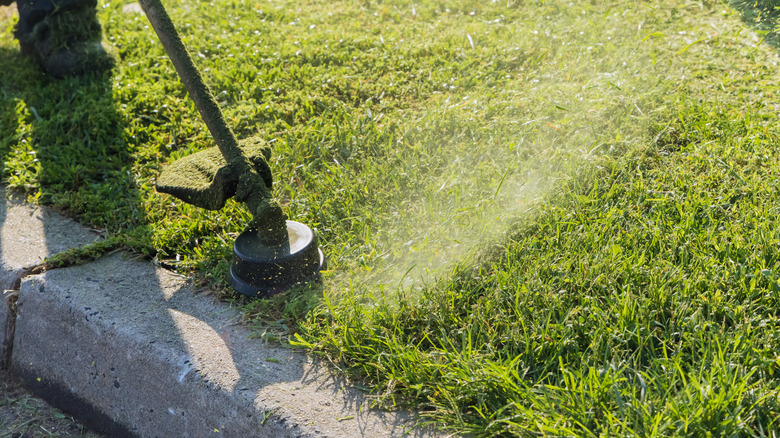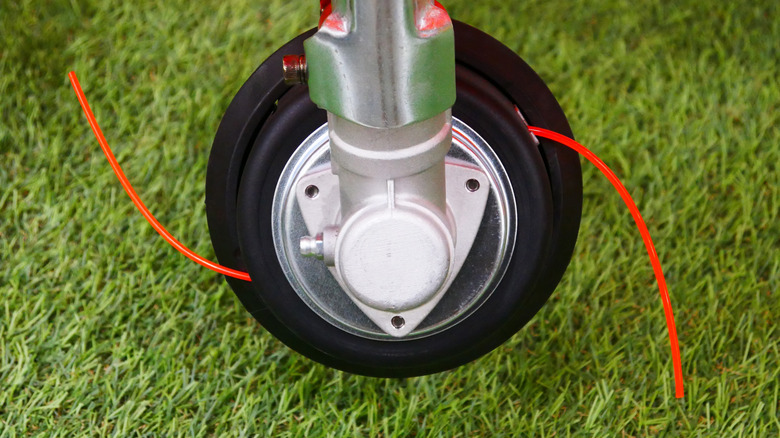The Weedeater Hack You Need For An Easier Time Cleaning Up Your Lawn
Anyone who owns, or has ever used, a string trimmer knows already that a video about string trimmers is likely to include crying, throwing a spool of trimmer line, or both. Trimming weeds and tall grass in areas where mowers aren't practical, such as against a fence or concrete slab, really makes string trimmers necessary, but the experience of using trimmer line can be incredibly frustrating. It's unbelievably fragile for something designed to spin at 7,000 RPM or more ... and there are other problems.
Holly — a fan of TikTok DIY guru, WD-40 enthusiast, and pool noodle aficionado @jmg8tor – complained that the line inside her trimmer head sticks together and refuses to feed properly. @jmg8tor explained that the sticky situation is caused when the line is wrapped backward on the trimmer head spool or not wrapped tightly enough. He has a point and, better yet, a couple of solutions.
Loosely wound trimmer line, or line that has been started incorrectly or wound backwards, can indeed contribute to a problem called "line weld." For various reasons, trimmer line can overheat and melt (that is, "weld") itself together. Some trimmer lines claim to be formulated to resist line welding, but this problem is still very common.
How to prevent line welding in your weed eater
Line weld happens because the material from which most trimmer line is made, nylon, begins to soften at temperatures as low as 140 degrees Fahrenheit. Heat builds up in the trimmer head from cutting against hard surfaces like concrete or simply from running it too fast for too long. This causes the nylon trimmer line to melt along its edges just enough to stick together so that you can't feed the line out properly when you need to.
Since improperly wound line can contribute to this problem, @jmg8tor recommends using a self-feeding head, one of the many types of string trimmer heads that controls how the line is wrapped when you load it. He suggests using an Echo string trimmer with a bump-feed head, which is probably the most common string trimmer or trimmer head recommendation you'll find online because of its quality. Stringing weed eaters with these two-hole heads has the added benefit of being very easy.
The other piece of advice @jmg8tor offers – soaking trimmer line in a bucket of water – might be on less solid ground. He suggests soaking as a method of making the line less likely to break, and that is usually true. But soaking might also exacerbate the line weld problem. Let's take a look at why.
Issues with soaking your nylon weed eater trimmer line
The conventional wisdom is that nylon trimmer line needs humidity to keep its ideal properties, and so it should be stored in a cool, humid environment, or it should be moistened occasionally ... perhaps by soaking in water. Nylon is hygroscopic and absorbs water from air (or from a bucket), so this restores the line's flexibility and makes it less likely to break. OK, it's still 100% going to break ... but somewhat less frequently. You can rehydrate nylon trimmer line in as little as 24 hours with sufficient humidity.
The problem is that nylon that has absorbed moisture picks up a couple of habits that increase the likelihood of line weld. One is that the plasticizing properties that make wetted line more flexible also make it stretch, which contributes to line weld. Moisture also reduces the temperature at which nylon melts. This is what plasticizers are meant to do... soften a crystalline polymer and make its melting point lower. Unfortunately, in the case of a string trimmer line, this is a recipe for increased line weld. Soaking weed-eater string is a lawn hack that also makes the trimmer line stronger in some regards, so it's not necessarily something to avoid. It's probably better to soak the line and try to manage the line's temperature by avoiding behaviors that make it overheat.


